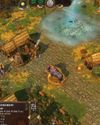
Knowledge was shared, through computer clubs and magazines, but games of the time were not made through teamwork – instead they were the godlike act of an individual typing the most efficient, creative and accurate code into an Apple II keyboard.
Thanks to the accessibility and simplicity of the tech, John Romero had developed dozens of published games before working on Wolfenstein 3D. His story was no exception – id’s other founding members, John Carmack, Adrian Carmack (no relation) and Tom Hall, had each spent their most formative decade in self-imposed solitary confinement, programming game after game.
It’s no surprise, then, that this history seeped into the culture of the studio. Though id Software worked together to create Wolfenstein 3D, Doom and Quake, its process wasn’t exactly collaborative by today’s standards. In the beginning, John Carmack would work solo to develop the next innovation in 3D graphics and AI. Then Romero and his fellow designers would build stages alone, placing every door, light and monster by hand.
SINGLE PLAYER
Denne historien er fra January 2021-utgaven av PC Gamer.
Start din 7-dagers gratis prøveperiode på Magzter GOLD for å få tilgang til tusenvis av utvalgte premiumhistorier og 9000+ magasiner og aviser.
Allerede abonnent ? Logg på
Denne historien er fra January 2021-utgaven av PC Gamer.
Start din 7-dagers gratis prøveperiode på Magzter GOLD for å få tilgang til tusenvis av utvalgte premiumhistorier og 9000+ magasiner og aviser.
Allerede abonnent? Logg på

A New Dawn - The rise, fall and rise again of PC Gaming in Japan
The so-called 'Paso Kon' market (ie katakana's transliteration of 'Pasonaru Computa') in Japan was originally spearheaded in the 1980s by NEC's PC-8800 and, later, its PC-9800.

MARVEL: ULTIMATE ALLIANCE
Enter the multiverse of modness.

SLIDES RULE
Redeeming a hated puzzle mechanic with SLIDER

GODS AND MONSTERS
AGE OF MYTHOLOGY: RETOLD modernises a classic RTS with care

PHANTOM BLADE ZERO
Less Sekiro, more Wo Long: Fallen Dynasty

STARR-MAKING ROLE
Final Fantasy XVI's BEN STARR talks becoming a meme and dating summons

THIEF GOLD
Learning to forgive myself for knocking out every single guard.

HANDHELD GAMING PCs
In lieu of more powerful processors, handhelds are getting weirder

FAR FAR AWAY
STAR WARS OUTLAWS succeeds at the little things, but not much else shines

FINDING IMMORTALITY
Twenty-five years on, PLANESCAPE: TORMENT is still one of the most talked-about RPGs of all time. This is the story of how it was created as a ‘stay-busy’ project by a small team at Black Isle Studios